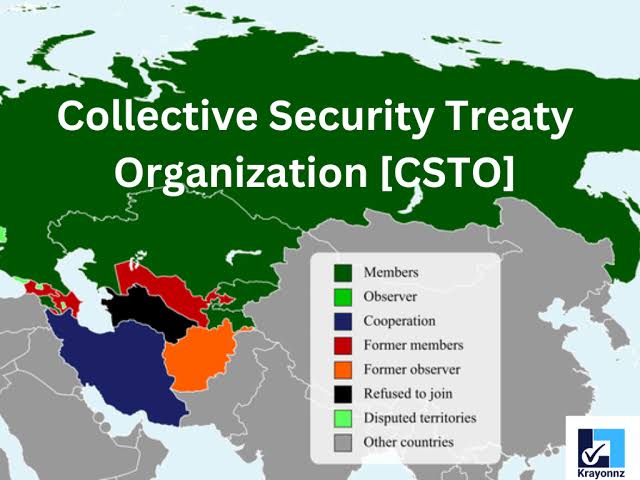Collective Security Treaty Organization

The Collective Security Treaty came into force on April 20, 1994 to herald the emergence what would eventually become the Collective Security Treaty Organization. The six member-countries are Russia, Armenia, Belarus, Kazakhstan, Kyrgyzstan, Tajikistan
The Collective Security Treaty came into force 30 years ago today, on April 20, 1994 to herald the emergence what would eventually become the Collective Security Treaty Organization (CSTO). The six member-countries are Russia, Armenia, Belarus, Kazakhstan, Kyrgyzstan, Tajikistan.
Signing, participants.
After the breakup of the Soviet Union and the establishment of the Commonwealth of Independent States (CIS), the member-states of the new integration association repeatedly attempted to preserve a common defence space to ensure security and counter escalations of armed conflicts on the territory of the former Union.
On May 15, 1992 the heads of Russia, Armenia, Kazakhstan, Kyrgyzstan, Tajikistan and Uzbekistan gathered in Uzbekistan’s capital Tashkent to sign the Collective Security Treaty. In 1993, three more countries joined in: Azerbaijan did so on September 24, Georgia on December 9, and Belarus on December 31.
The treaty was the first attempt to create a system of collective security that would cover the entire post-Soviet space. The other CIS states refused to participate.
The treaty did not set a task of creating a military bloc, but envisioned a mechanism of coordinated action in the interests of ensuring the signatories’ collective security and territorial integrity.
The treaty entered into force on April 20, 1994 for a period of five years with subsequent prolongations. On April 2, 1999, Azerbaijan, Georgia and Uzbekistan refused to sign the protocol on the extension of the treaty and quit.
These three countries preferred to cooperate within the GUUAM (a regional organization that united Georgia, Uzbekistan, Ukraine, Azerbaijan, and Moldova; currently GUAM, as Uzbekistan has left the group since). Uzbekistan later resumed its membership of the CSTO in August 2006, but left the organization again in December 2012.
CSTO establishment, membership
On May 14, 2002, the treaty was upgraded to an international regional organization. At a summit in Moscow, the heads of the CSTO countries promulgated the establishment of the Collective Security Treaty Organization. On October 7 of the same year the CSTO Charter and an agreement on the CSTO legal status were signed. Since 2004, the organization has enjoyed an observer status at the UN General Assembly.
Currently, the CSTO members are Russia, Armenia, Belarus, Kazakhstan, Kyrgyzstan and Tajikistan. However, in 2024, Armenian Prime Minister Nikol Pashinyan said that his country had “suspended participation” in the CSTO. He argued that the Collective Security Treaty “has not been fulfilled with regard to Armenia, especially in 2021-2022,” when Armenia’s conflict with Azerbaijan went into high gear.
Executive bodies
The Collective Security Council (CSC) – the CSTO’s supreme political body – includes the heads of the organization’s member-countries. The secretary-general-led Secretariat is the highest coordinating body. Imangali Tasmagambetov, of Kazakhstan, has been the CSTO’s Secretary-General since January 1, 2023. Kazakhstan holds the rotating presidency of the CSTO in 2024.
CSTO goals and objectives
The main goal of the CSTO is to ward off the threats to security and stability and to protect the territorial integrity and sovereignty of member-states without interfering in their internal affairs. Military and political relations among the member-states enjoy priority over military ties and contacts with third countries. Military bases of non-CSTO countries can be stationed on the territories of CSTO members only with the consent of all other partners in the bloc.
CSTO members are obliged not to join military alliances with third countries or engage in actions directed against other member-states.
Aggression against one of the CSTO members (an armed attack threatening security, stability, territorial integrity or sovereignty) is considered as aggression against all of the treaty’s signatories.
The treaty is not directed against third countries. Nor does it affect the rights and obligations of the CSTO countries under bilateral agreements or the right of the participating states to individual and collective defense against aggression in accordance with the UN Charter.
Collective Security System
The CSTO collective security system includes the Collective Rapid Reaction Force (CRRF; about 18,000 men), the Peacekeeping Force (3,600 men), the Collective Aviation Force (CAF), and regional groups: Collective Rapid Deployment Force in the Central Asian Region (CRDF CAR; about 5,000 men), and East European (Russia and Belarus) and Caucasus (Russia and Armenia) groups. All these structures are included in the unified troops of the organization – the Collective Forces, established on December 19, 2012.
The CSTO Joint Staff is responsible for drafting proposals and implementing decisions concerning the military component of the Collective Security Treaty.
The organization also has a mechanism for military-technical cooperation, which provides for the supply of military products to the member-countries at a discount, and for the training of personnel for the armed forces and security agencies of CSTO member-countries free or on preferential terms.
Within the framework of military cooperation, the CSTO member-countries have conducted annual joint exercises: since 2004, the command and staff exercise Frontier, since 2009, the Interaction comprehensive exercise involving the CRRF and since 2010, the Cobalt special forces exercise. In October 2012, the first peacekeeping exercise Indestructible Brotherhood was held. Since 2017 the Indestructible Brotherhood, Interaction and other exercises have been conducted as part of the operational-strategic exercise Combat Brotherhood.



